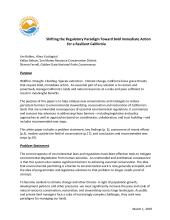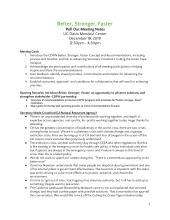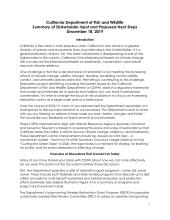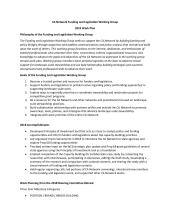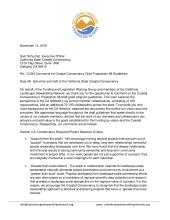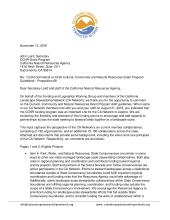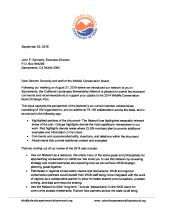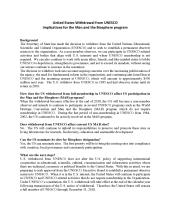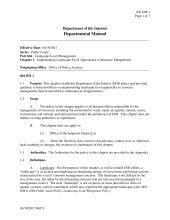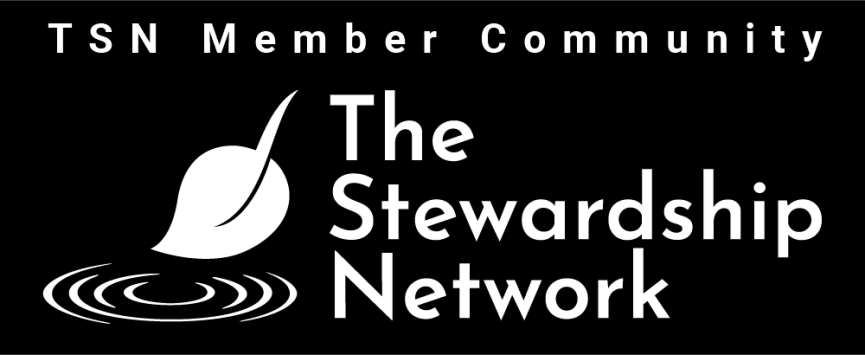Learn more about the state and national policy initiatives and funding programs that shape the work we do.
California Landscape Stewardship Network, 2019
Proposes reforms to streamline permitting and accelerate restoration, urging bold regulatory shifts to meet California’s urgent climate and ecological challenges.
- Details
-
Wildfire. Drought. Flooding. Species extinction. Climate change. California faces grave threats that require bold, immediate action. An essential part of any solution is to restore and proactively manage California’s lands and natural resources at a scale and pace sufficient to result in meaningful benefits.
The purpose of this paper is to help catalyze new conversations and strategies to reduce persistent barriers to environmental stewardship, conservation and restoration of California’s lands that are unintended consequences of essential environmental regulations. It summarizes and assesses key advances in addressing these barriers—including legislative and policy approaches as well as approaches based on coordination, collaboration, and trust building—and includes recommended next steps.
This white paper includes a problem statement, key findings (p. 3), assessment of recent efforts (p.3), models outside the field of conservation (p.17), and conclusions and recommended next steps (p.19).
California Department Fish and Wildlife, December 2019
Documents remarks and group discussions from CDFW’s reform rollout event at UC Davis.
- Details
-
Meeting notes, including summaries of speaker remarks and small group discussions, from the Better, Stronger, Faster roll-out at the UC Davis Mondavi Center on December 18, 2019.
California Department Fish and Wildlife, December 2019
Shares CDFW’s proposed reforms based on stakeholder feedback to improve permitting processes.
- Details
-
Over the course of 2018-19, many of you approached the California Department Fish and Wildlife separately or in small groups to discuss improvements to our processes. The Department wants to share with you our thinking on reforms to help make our work “better, stronger, and faster.” We would like your feedback on improvements to our processes.
California Landscape Stewardship Network, 2018
Details strategic priorities for advancing stewardship funding and policy, including advocacy, partnerships, and capacity building.
California Landscape Stewardship Network, November 2018
CLSN provides input on draft guidelines to ensure Proposition 68 funds support inclusive, landscape-scale restoration and stewardship efforts.
California Landscape Stewardship Network, November 2018
California Landscape Stewardship Network, September 2018
CLSN offers feedback to improve the Wildlife Conservation Board’s strategic plan, emphasizing landscape-scale stewardship and collaborative conservation approaches.
- Details
-
Comments and recommendations submitted by the California Landscape Stewardship Network to the California Wildlife Conservation Board regarding their 2014 Strategic Plan update.
California Natural Resources Agency, December 2018
Captures input and process design for launching CGT initiative and improving restoration permitting.
- Details
-
Meeting Goals
- Share the vision for Cutting the Green Tape.
- Gather input to inform the overall design for the initiative.
- Establish process and confirm timeline.
UNESCO, October 2017
Analyzes the impact of U.S. withdrawal from UNESCO on biosphere programs, raising concerns about global collaboration and conservation leadership.
- Details
-
The Secretary of State has made the decision to withdraw from the United Nations Educational, Scientific and Cultural Organization (UNESCO) and to seek to establish a permanent observer mission to the organization.
US Department of Interior, January 2017
Provides DOI guidance for managing natural resources at landscape scale to improve ecological outcomes.
- Details
-
This chapter from the Department of Interior (DOI) Manual establishes policy and provides guidance to bureaus/offices on implementing landscape-level approaches to resource management. It highlights the need to meaningfully coordinate with diverse stakeholders, consider actions and implications at multiple scales, take integrative and interdisciplinary approaches to landscape management, and improving resilience by working at landscape scales.


